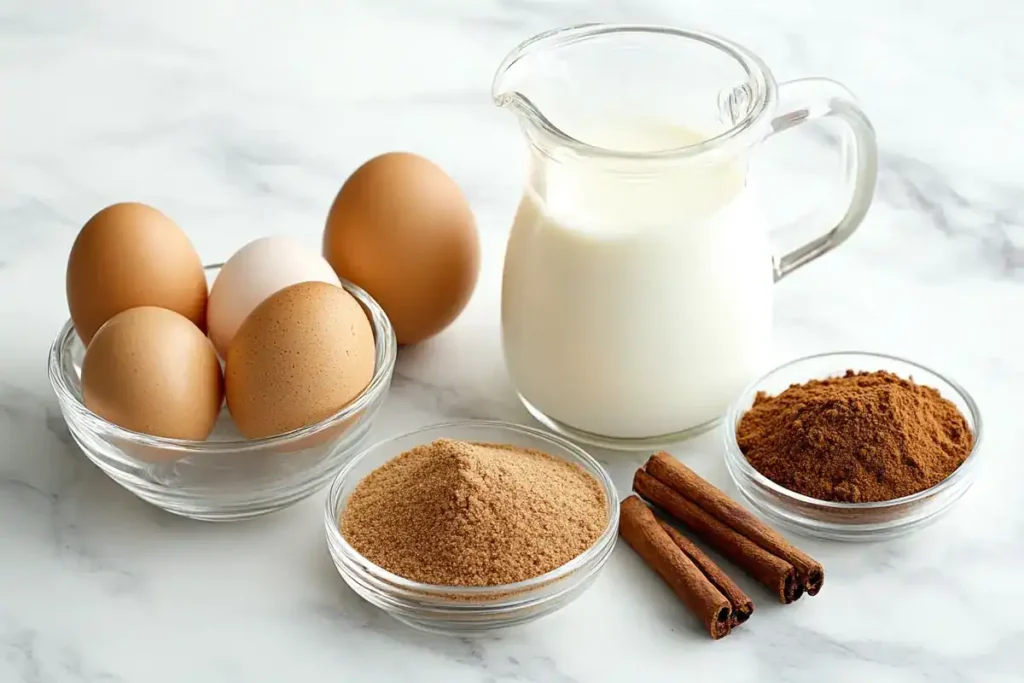introduction
Baked French toast is a delightful breakfast dish, combining soft bread with a creamy custard and baked to golden perfection. However, many home cooks find themselves asking, “Why is my baked French toast soggy?” This common issue can make an otherwise comforting meal less than satisfying.
In this article, we’ll explore the main reasons behind soggy baked French toast and share tips to fix and avoid these pitfalls. From choosing the right bread to mastering the custard mixture, we’ll guide you step by step. Whether you’re new to baking French toast or refining your technique, these insights will help you serve a perfect dish every time.
Common Causes of Soggy Baked French Toast
Using the Wrong Bread
One of the most common culprits behind soggy baked French toast is the type of bread used. Soft, pre-sliced sandwich bread may absorb too much custard, resulting in a mushy texture. Instead, opt for sturdy bread like brioche, challah, or sourdough. These types hold their structure even after soaking in the custard.
Another important factor is the bread’s freshness. Fresh bread tends to soak up custard too quickly, making it harder to achieve a firm texture after baking. Slightly stale bread is ideal because it absorbs custard more evenly without becoming oversaturated. If your bread is too fresh, lightly toast it to mimic the texture of day-old bread.
Imbalanced Custard Mixture
The custard mixture plays a significant role in determining the texture of baked French toast. A common mistake is adding too much milk, which dilutes the eggs and creates an overly wet base. The ideal ratio is roughly 1/2 cup of milk for every large egg, as this ensures a creamy but not watery consistency.
Additionally, be sure to whisk the custard thoroughly. Incomplete mixing can lead to uneven distribution, resulting in some slices of bread becoming soggy while others remain dry. Incorporating spices like cinnamon or nutmeg can also help balance the flavors, enhancing the overall dish.
By addressing these two critical factors—bread choice and custard consistency—you’ll be well on your way to avoiding soggy baked French toast.
Essential Ingredients and Tools for Baked French Toast
The Best Bread for Baking French Toast
Bread is the foundation of baked French toast, and selecting the right type can prevent sogginess. Why is my baked French toast soggy? Often, it’s because the bread is too soft or fresh. Instead, choose:
- Brioche: Its rich, buttery flavor pairs perfectly with custard.
- Challah: Slightly sweet and sturdy, ideal for holding custard without breaking apart.
- Sourdough: Adds a slight tanginess and maintains structure even after soaking.
Allowing the bread to sit out overnight can help it dry slightly, improving its ability to absorb custard evenly.
Tools You’ll Need for the Recipe
Having the right tools ensures smooth preparation:
- Baking Dish: A glass or ceramic dish provides even heating.
- Whisk: Essential for blending the custard to a smooth consistency.
- Measuring Cups: For accurate ingredient portions.
- Spatula: Makes transferring slices easier without breaking them.
Equipping your kitchen with these essentials sets you up for success when making baked French toast.

Step-by-Step Recipe for Perfect Baked French Toast
Ingredients List
Here’s what you’ll need to create this dish:
- 1 loaf of brioche or challah bread (preferably day-old)
- 4 large eggs
- 2 cups whole milk
- 1/4 cup heavy cream
- 1/4 cup granulated sugar
- 1 tsp vanilla extract
- 1/2 tsp ground cinnamon
- 1/4 tsp nutmeg (optional)
- Butter or nonstick spray for greasing
Preparation Instructions
- Prep the Bread: Slice the bread into thick slices (about 1 inch each). Lay them out in a single layer to air-dry slightly.
- Make the Custard: In a large mixing bowl, whisk together eggs, milk, cream, sugar, vanilla, cinnamon, and nutmeg. Ensure the mixture is well combined for even soaking.
- Grease the Dish: Lightly grease your baking dish with butter or nonstick spray to prevent sticking.
Baking Instructions
- Assemble the Layers: Arrange the bread slices in the dish, slightly overlapping if needed. Pour the custard mixture evenly over the bread, ensuring every slice is soaked.
- Soak: Cover the dish with plastic wrap and let it sit in the refrigerator for at least 30 minutes or overnight for best results.
- Bake: Preheat your oven to 350°F (175°C). Remove the dish from the fridge and bake uncovered for 35–45 minutes, or until the top is golden brown and slightly crispy.
- Cool and Serve: Allow the French toast to cool for 5 minutes before serving. Add toppings like powdered sugar, fresh fruit, or syrup.
Optional Toppings and Variations
- Sweet Toppings: Add fresh berries, whipped cream, or a drizzle of honey for a touch of sweetness.
- Savory Twist: Skip the sugar and spices in the custard and top with cheese or sautéed vegetables for a unique variation.

Nutritional Content (Per 100g)
| Nutrient | Value |
|---|---|
| Calories | 210 |
| Carbohydrates | 25g |
| Protein | 7g |
| Fat | 8g |
| Sodium | 220mg |
| Fiber | 1g |
Tips to Avoid Soggy Baked French Toast
Choosing the Right Custard Consistency
One of the top answers to “Why is my baked French toast soggy?” lies in the custard. When the egg-to-milk ratio is off, the mixture becomes too watery, leaving you with soggy bread. A foolproof tip is to use four eggs for every two cups of milk or cream. This balance creates a creamy texture while still firming up during baking.
Additionally, whisk the custard thoroughly to ensure the eggs are fully integrated. If the mixture appears too thin, you can add an extra egg or a splash of heavy cream to adjust the consistency.
Baking Temperature and Timing
Another key factor is the oven settings. Baking at too low a temperature often results in a soggy middle, as the custard doesn’t set properly. The ideal temperature is 350°F (175°C). This allows the French toast to bake evenly, with a crisp golden top and a soft, but not mushy, interior.
To ensure consistent baking, place the dish on the middle rack of the oven. Check the toast after 30 minutes by inserting a toothpick into the center. If it comes out clean, the dish is ready. If not, give it another 5–10 minutes while keeping an eye on the edges to prevent over-browning.
For additional breakfast inspiration, check out this delicious breakfast recipe article that pairs perfectly with baked French toast!
FAQs About Soggy French Toast
How Do You Fix Soggy French Toast?
If your baked French toast turns out soggy, don’t panic—there are ways to salvage it. First, return it to the oven for another 10–15 minutes at 350°F. Cover the dish with aluminum foil to prevent the top from burning while allowing the custard to fully set.
Another option is to slice the soggy portions into smaller pieces and pan-fry them in a nonstick skillet. This method helps crisp up the edges while reducing excess moisture.
What Is the Most Common Mistake in Making French Toast?
The most common mistake in making baked French toast is over-soaking the bread. Allow the bread to absorb the custard mixture, but avoid leaving it submerged for too long. A quick soak on each side is often sufficient, especially for softer breads.
Additionally, using bread that is too fresh or failing to dry it out beforehand can lead to sogginess. Choosing sturdy bread and letting it air-dry overnight helps avoid this issue.
How Do You Keep Toast from Getting Soggy?
To keep baked French toast from getting soggy, ensure you bake it immediately after soaking or refrigerating it overnight. Preheating the oven properly also prevents uneven baking, which can lead to a mushy texture.
For reheating, use a conventional oven instead of a microwave to preserve the texture. Place leftovers in a preheated oven at 350°F for 10 minutes to restore their crispness.
How Long Should You Soak French Toast Before Cooking?
The ideal soak time for French toast depends on the thickness of the bread. Thin slices require only 10–15 seconds per side, while thicker slices can handle 30 seconds to a minute. For baked French toast, ensure the bread is coated but not drenched, as it will soak further while resting in the dish before baking.
By addressing these common concerns, you can confidently tackle the challenges of making baked French toast and turn it into a breakfast masterpiece.
Variations on Baked French Toast
French toast is a versatile dish that can be tailored to fit sweet or savory preferences. Once you’ve mastered the basics and resolved the question, “Why is my baked French toast soggy?”, it’s time to experiment with creative variations that elevate the dish to the next level.
Savory Baked French Toast
For those who enjoy savory breakfasts, baked French toast can be transformed with just a few ingredient swaps:
- Custard Adjustments: Skip the sugar and cinnamon in the custard. Instead, add a pinch of salt, black pepper, and fresh herbs like parsley or chives.
- Toppings: Sprinkle shredded cheese, sautéed vegetables, or cooked breakfast sausage on top before baking.
- Serving Suggestions: Pair with a fresh salad or roasted potatoes for a hearty brunch option.
Savory baked French toast is perfect for occasions when you want something filling yet slightly different from the traditional sweet version.
Sweet Flavor Variations
For a dessert-like experience, you can add decadent ingredients to your baked French toast:
- Chocolate and Nutella: Swirl Nutella into the custard or sprinkle chocolate chips between the layers of bread.
- Cinnamon Roll Style: Add a mixture of brown sugar, cinnamon, and melted butter between the bread layers for a gooey cinnamon roll-inspired dish.
- Fruit Additions: Layer sliced bananas, fresh berries, or even caramelized apples into the dish for bursts of natural sweetness.
By customizing your recipe with these variations, you’ll never grow tired of baked French toast.

Storing and Reheating Baked French Toast
If you have leftovers, proper storage and reheating are essential to maintain the dish’s texture and flavor. This is especially important if you’ve solved the “Why is my baked French toast soggy?” issue and want to keep it crisp and delicious for later.
Storage Tips for Freshness
To store baked French toast:
- Allow it to cool completely before storing.
- Wrap the dish tightly in plastic wrap or transfer individual portions to airtight containers.
- Refrigerate for up to 3 days or freeze for up to 3 months.
If freezing, separate slices with parchment paper to prevent them from sticking together.
Reheating Tips
To reheat baked French toast without losing its texture:
- Oven Method: Preheat the oven to 350°F (175°C). Place slices on a baking sheet and heat for 10–15 minutes. This method restores the crisp edges and warms the center evenly.
- Stovetop Method: Heat a nonstick skillet over medium heat. Lightly butter the skillet and reheat each slice for 2–3 minutes on each side for a slightly toasted finish.
- Microwave Method: Place a slice on a microwave-safe plate and cover with a damp paper towel. Heat in 20-second intervals to avoid overcooking.
Proper reheating ensures that your baked French toast remains just as satisfying as when it was first served. For more breakfast ideas, visit PamPam Recipes and explore a variety of creative dishes.
Why Baked French Toast Is Worth Perfecting
Baked French toast is more than just a breakfast dish—it’s a crowd-pleaser that can transform any morning into a special occasion. While it may require some attention to detail, once you’ve tackled issues like “Why is my baked French toast soggy?”, the results are absolutely worth it.
Perfect for Entertaining
Baked French toast is ideal for hosting because it can be prepared ahead of time. By assembling the dish the night before, you free up time to focus on other preparations or simply enjoy your morning. Additionally, its ability to serve a crowd without requiring individual cooking makes it both convenient and impressive.
A Versatile Dish
Another reason to love baked French toast is its versatility. Whether you’re sticking to the classic recipe or exploring unique variations, it’s easy to adapt to dietary preferences and flavor profiles. From sweet to savory, this dish offers endless opportunities to experiment.
With its balance of simplicity and elegance, baked French toast is a dish that deserves a place in every home cook’s repertoire.
also you can check this article:
What Is the Most Common Mistake in Making French Toast?
Final Thoughts
If you’ve ever wondered, “Why is my baked French toast soggy?”, you now have all the answers and tips to solve this common problem. By understanding the role of each ingredient, perfecting your technique, and customizing the recipe to your liking, you can create a dish that’s not only delicious but also foolproof.
Key Takeaways
Here are the most important points to remember:
- Use sturdy, slightly stale bread for the best texture.
- Maintain a proper egg-to-milk ratio in the custard to avoid excess moisture.
- Bake at 350°F (175°C) for even cooking and a golden finish.
- Customize with creative toppings or variations to suit your preferences.
Keep Experimenting
Perfecting baked French toast is a rewarding journey. Once you’ve mastered the basics, don’t hesitate to try new ingredients or techniques. Whether it’s adding a swirl of Nutella, trying a savory version, or experimenting with global flavors, the possibilities are endless.

